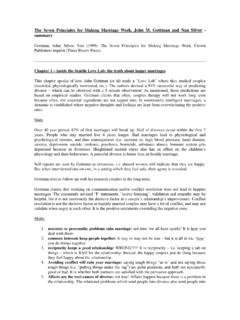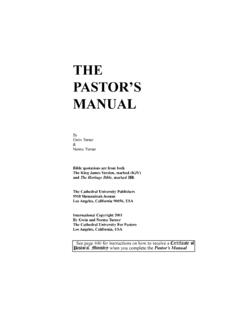Transcription of Information sharing: advice for practitioners - GOV.UK
1 Information sharing advice for practitioners providing safeguarding services to children, young people, parents and carers July 2018. Contents Summary 3. About this government advice 3. The seven golden rules to sharing Information 4. sharing Information 6. Being alert to signs of abuse and neglect and taking action 6. Legislative framework 7. The principles 9. Necessary and proportionate 9. Relevant 9. Adequate 9. Accurate 9. Timely 9. Secure 10. Record 10. When and how to share Information 11. When 11. How 11. Flowchart of when and how to share Information 12. Myth-busting guide 13. Useful resources and external organisations 15. Other relevant departmental advice and statutory guidance 15. 2. Summary Information sharing is essential for effective safeguarding and promoting the welfare of children and young people.
2 It is a key factor identified in many serious case reviews (SCRs), where poor Information sharing has resulted in missed opportunities to take action that keeps children and young people safe. About this government advice This HM Government advice is non-statutory, and has been produced to support practitioners in the decisions they take to share Information , which reduces the risk of harm to children and young people and promotes their well-being. This guidance does not deal in detail with arrangements for bulk or pre-agreed sharing of personal Information between IT systems or organisations other than to explain their role in effective Information governance. This guidance has been updated to reflect the General Data Protection Regulation (GDPR) and Data Protection Act 2018, and it supersedes the HM Government Information sharing : guidance for practitioners and managers published in March 2015.
3 Who is this advice for? This advice is for all frontline practitioners and senior managers working with children, young people, parents and carers who have to make decisions about sharing personal Information on a case-by-case basis. It might also be helpful for practitioners working with adults who are responsible for children who may be in need. 3. The seven golden rules to sharing Information 1. Remember that the General Data Protection Regulation (GDPR), Data Protection Act 2018 and human rights law are not barriers to justified Information sharing , but provide a framework to ensure that personal Information about living individuals is shared appropriately. 2. Be open and honest with the individual (and/or their family where appropriate). from the outset about why, what, how and with whom Information will, or could be shared, and seek their agreement, unless it is unsafe or inappropriate to do so.
4 3. Seek advice from other practitioners , or your Information governance lead, if you are in any doubt about sharing the Information concerned, without disclosing the identity of the individual where possible. 4. Where possible, share Information with consent, and where possible, respect the wishes of those who do not consent to having their Information shared. Under the GDPR and Data Protection Act 2018 you may share Information without consent if, in your judgement, there is a lawful basis to do so, such as where safety may be at risk. You will need to base your judgement on the facts of the case. When you are sharing or requesting personal Information from someone, be clear of the basis upon which you are doing so. Where you do not have consent, be mindful that an individual might not expect Information to be shared.
5 5. Consider safety and well-being: base your Information sharing decisions on considerations of the safety and well-being of the individual and others who may be affected by their actions. 6. Necessary, proportionate, relevant, adequate, accurate, timely and secure: ensure that the Information you share is necessary for the purpose for which you are sharing it, is shared only with those individuals who need to have it, is accurate and up- to-date, is shared in a timely fashion, and is shared securely (see principles ). 7. Keep a record of your decision and the reasons for it whether it is to share Information or not. If you decide to share, then record what you have shared, with whom and for what purpose. 4. The General Data Protection Regulation (GDPR) and Data Protection Act 2018. The General Data Protection Regulation (GDPR) and the Data Protection Act 2018.
6 Introduce new elements to the data protection regime, superseding the Data Protection Act 1998. practitioners must have due regard to the relevant data protection principles which allow them to share personal Information , The GDPR and Data Protection Act 2018 place greater significance on organisations being transparent and accountable in relation to their use of data. All organisations handling personal data need to have comprehensive and proportionate arrangements for collecting, storing, and sharing Information . The GDPR and Data Protection Act 2018 do not prevent, or limit, the sharing of Information for the purposes of keeping children and young people safe. To effectively share Information : all practitioners should be confident of the processing conditions, which allow them to store, and share, the Information that they need to carry out their safeguarding role.
7 Information which is relevant to safeguarding will often be data which is considered special category personal data' meaning it is sensitive and personal where practitioners need to share special category personal data, they should be aware that the Data Protection Act 2018 includes safeguarding of children and individuals at risk' as a condition that allows practitioners to share Information without consent Information can be shared legally without consent, if a practitioner is unable to, cannot be reasonably expected to gain consent from the individual, or if to gain consent could place a child at risk. relevant personal Information can be shared lawfully if it is to keep a child or individual at risk safe from neglect or physical, emotional or mental harm, or if it is protecting their physical, mental, or emotional well-being.
8 5. sharing Information sharing Information is an intrinsic part of any frontline practitioners ' job when working with children and young people. The decisions about how much Information to share, with whom and when, can have a profound impact on individuals' lives. Information sharing helps to ensure that an individual receives the right services at the right time and prevents a need from becoming more acute and difficult to meet. Poor or non-existent Information sharing is a factor repeatedly identified as an issue in Serious Case Reviews (SCRs) carried out following the death of or serious injury to, a child. In some situations, sharing Information can be the difference between life and death. Fears about sharing Information cannot be allowed to stand in the way of the need to safeguard and promote the welfare of children at risk of abuse or neglect.
9 Every practitioner must take responsibility for sharing the Information they hold, and cannot assume that someone else will pass on Information , which may be critical to keeping a child safe. Professor Munro's review of child protection concluded the need to move towards a child protection system with less central prescription and interference, where we place greater trust in, and responsibility on, skilled practitioners at the frontline. 1 Those skilled practitioners are in the best position to use their professional judgement about when to share Information with colleagues working within the same organisation, as well as with those working within other organisations, in order to provide effective early help, to promote their welfare, and to keep children safe from harm. Lord Laming emphasised that the safety and welfare of children is of paramount importance and highlighted the importance of practitioners feeling confident about when and how Information can be legally shared.
10 2 He recommended that all staff in every service, from frontline practitioners to managers in statutory services and the voluntary sector should understand the circumstances in which they may lawfully share Information , and that it is in the public interest to prioritise the safety and welfare of children. Being alert to signs of abuse and neglect and taking action All practitioners should be alert to the signs and triggers of child abuse and neglect. 3. Abuse (emotional, physical and sexual) and neglect can present in many different forms. Indicators of abuse and neglect may be difficult to spot. Children may disclose abuse, in 1. The Munro review of child protection: final report a child centred system 2. The Protection of Children in England: a progress plan 3. What to do if you're worried a child is being abused 6.











